Let’s make homemade breakfast pastries using a variation of classic Danish pastry dough. We’re working the butter directly into the dough, which is a different method from laminating it with separate layers of butter. These breakfast pastries are buttery and flaky with sweet fillings and a drizzle of vanilla icing. For best success, use the video tutorial and photos, as well as the carefully explained recipe for guidance.
This recipe is brought to you in partnership with Red Star Yeast.

Do you remember when I published a shortcut variation of Danish pastry dough? You might not—it was several years ago! Since then, I’ve created a raspberry pastry braid and a blueberry cream cheese pastry braid using that same dough. Let’s take it a step further and make individual homemade breakfast pastries.
Researching their origin, I learned that traditional Danish pastries came to life around the 1850s by Austrian bakers working in Denmark. What started as the Austrian pastry known as Plundergebäck developed into what is now known as danishes. There are many ways to make, top, shape, and serve these pastries and that usually depends on the region. Here in the US, we can usually find them topped with fruit, jams, and sweetened cream cheese fillings. Bottom line: we’re all so very thankful for these sweets!
This is a Shortcut Homemade Pastry
Before I describe these homemade pastries and show you how to make them, let me explain this pastry dough variation. This is a shortcut version—it’s not the traditional method of making real danishes. This dough is usually laminated several times between layers of butter, similar to how we prepare homemade croissants and croissant bread. Here we are working the butter directly into the dough using a food processor. We’re still rolling out and folding the dough, just as you do when you laminate dough with butter, but we’re not folding it up with a separate layer of butter.
I use the term “shortcut” loosely as this dough still takes at least 5-6 hours total with 2 rounds of refrigeration. They’re just as buttery and flaky as the real thing!
Are you looking for a dough that’s more similar to puff pastry? We skip the lamination in this rough puff pastry dough as well. (And that recipe skips yeast unlike today’s yeasted dough, which creates slightly puffier pastries.)
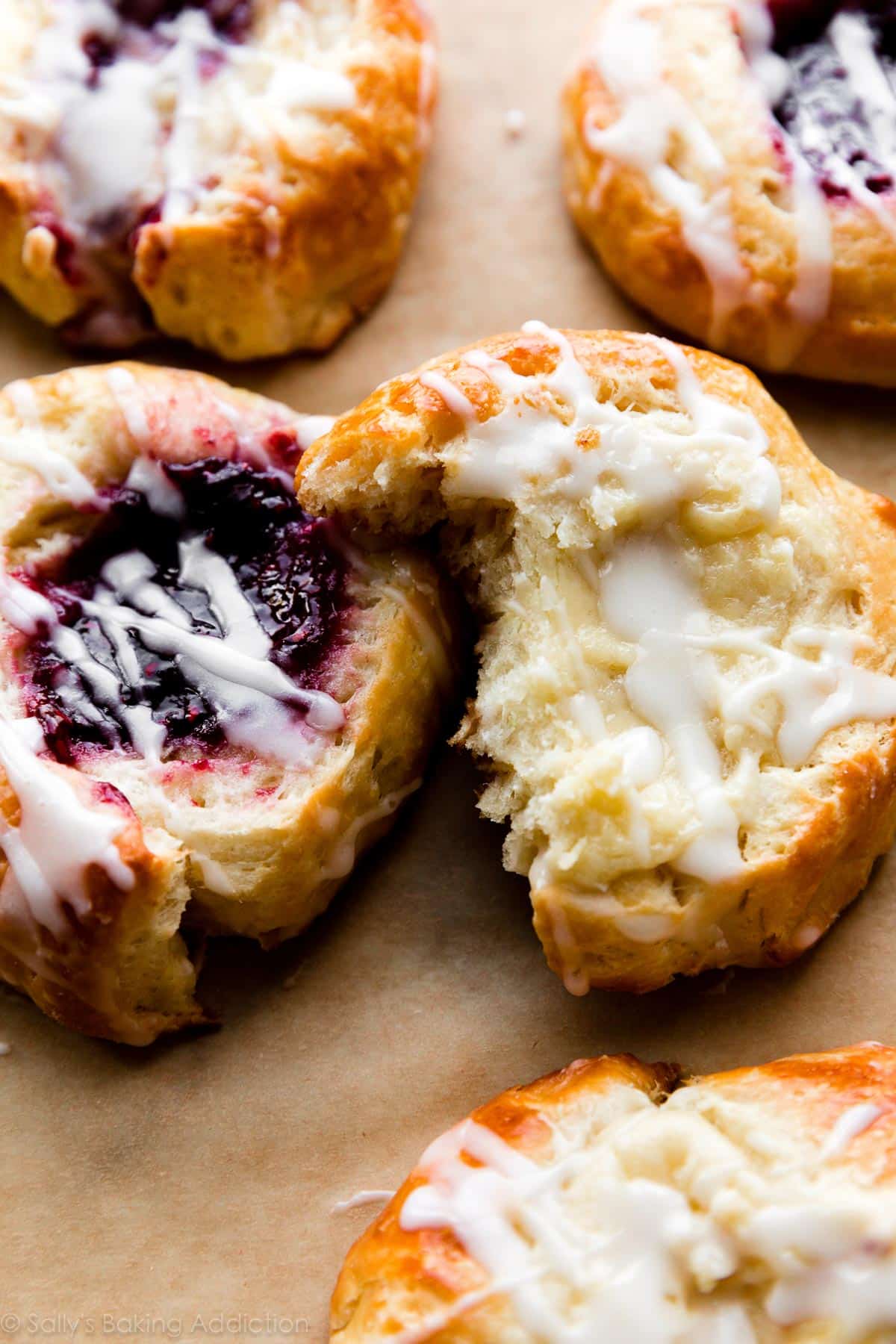
I have the full written recipe below, as well as step-by-step photos and careful explanations below the recipe. This post is rather long, so I wanted to add most of the details below the recipe. I can’t wait for you to try these at home!
These Homemade Danish Pastries Are:
- Made from a modified yeasted pastry dough
- Crisp, flaky, & extra buttery
- Ready for your favorite breakfast pastry fillings
- Topped with sweet vanilla icing
Plus, you can easily make this dough in 1 morning or over the course of 3 days. I love make-ahead dough where you have plenty of options in terms of timing. You can also freeze half the dough if 16 pastries are too many or even make 8 pastries and 1 blueberry cream cheese pastry braid!

Filling Ideas
You need around 2/3 cup of filling for the entire recipe (16 breakfast pastries). Feel free to mix and match, creating different flavors in your batch.
- Jam or Preserves, such as raspberry, peach, or strawberry
- Pumpkin Butter or Apple Butter
- Lemon Curd
- Cherry Pie Filling
- Nutella
- Cream Cheese Filling (my favorite and detailed in the recipe below)
Use This Dough to Make Pastry Braids
I love a versatile dough! Just as we can use pizza dough to make pizza, cheesy breadsticks, garlic knots, and pepperoni pizza rolls, we can use this homemade pastry dough to make individual pastries and pastry braids. I haven’t perfected other shapes yet, but feel free to try. Make sure you chill any shaped pastries before baking to help guarantee they hold their shape. See step 13 and corresponding recipe note below.
Baker’s Tip: I find that the braids bake up even flakier than the individual pastries! I have a video tutorial showing you how to shape this blueberry cream cheese pastry braid. It’s easier than it looks.

See Your Breakfast Pastries!
Many readers tried this recipe as part of a baking challenge! Feel free to email or share your recipe photos with us on social media. 🙂
Step-by-step photos below!
Print
Danish Pastries with Shortcut Homemade Dough
- Prep Time: 6 hours (includes chilling)
- Cook Time: 20 minutes
- Total Time: 6 hours, 25 minutes
- Yield: 16 pastries
- Category: Breakfast
- Method: Baking
- Cuisine: Danish
Description
These homemade breakfast pastries use a variation of classic Danish pastry dough. We’re working the butter directly into the dough, which is a different method from laminating it with separate layers of butter. Make sure the butter is very cold before beginning. This recipe yields 2 pounds of dough.
Ingredients
Pastry Dough
- 1/4 cup (60ml) warm water (between 100-110°F, 38-43°C)
- 2 and 1/4 teaspoons Platinum Yeast from Red Star (1 standard packet)*
- 1/4 cup (50g) granulated sugar
- 1/2 cup (120ml) whole milk, at room temperature (between 68–72°F, 20-22°C)
- 1 large egg, at room temperature
- 1 teaspoon salt
- 14 Tablespoons (196g) unsalted butter, cold
- 2 and 1/2 cups (313g) all-purpose flour (spooned & leveled), plus more for generously flouring hands, surface, and dough
Filling
- 2/3 cup filling (see recipe notes for options & cheese filling)
Egg Wash
- 1 large egg
- 2 Tablespoons (30ml) milk
Vanilla Icing (Optional)
- 1 cup (120g) confectioners’ sugar
- 2 Tablespoons (30ml) milk or heavy cream
- 1 teaspoon pure vanilla extract
Instructions
- Preliminary note: To help guarantee success, I recommend reading through the recipe, watching the video tutorial, and reading the explanations below this recipe. (All answer many FAQs.) Do not use an electric mixer for this dough. It’s best if the dough is folded together with a wooden spoon or rubber spatula since it is so sticky. There is very minimal mixing required.
- Make the Pastry Dough: Whisk the warm water, yeast, and 1 Tablespoon (6g) of sugar together in a large bowl. Cover and allow to rest until foamy on top, about 5 minutes. If the surface doesn’t have bubbles on top or look foamy after 15 minutes (it should if the yeast isn’t expired), start over with a fresh packet of yeast. Whisk in remaining sugar, the milk, egg, and salt. Once these wet ingredients are mixed together, lightly cover and set the bowl aside as you work on the next step.
- Cut the cold butter into 1/4 inch slices and add to a food processor or blender. Top with 2 and 1/2 cups flour. Pulse the mixture 12-15 times, until butter is crumbled into pea-size bits. See photo below for a visual. Using a food processor or blender is best for this dough. Keeping that in mind, if you don’t have one, you can use a pastry cutter to work in the butter.
- Pour the flour mixture into the wet yeast mixture. Very gently fold everything together using a rubber spatula or wooden spoon. Fold *just until* the dry ingredients are moistened. The butter must remain in pieces and crumbles, which creates a flaky pastry. Turn the sticky dough out onto a large piece of plastic wrap, parchment paper, aluminum foil, or into any container you can tightly cover.
- 1st Refrigeration: Wrap the dough/cover up tightly and refrigerate for at least 4 hours and up to 48 hours.
- Roll & Fold: Take the dough out of the refrigerator to begin the “rolling and folding” process. If the dough sat for more than 4 hours, it may have slightly puffed up and that’s ok. (It will deflate as you shape it, which is also ok.) Very generously flour a work surface. The dough is very sticky, so make sure you have more flour nearby as you roll and fold. Using the palm of your hands, gently flatten the dough into a small square. Using a rolling pin, roll out into a 15×8 inch rectangle. When needed, flour the work surface and dough as you are rolling. Fold the dough into thirds as if it were a business letter. (See photos and video tutorial.) Turn it clockwise and roll it out into a 15 inch long rectangle again. Then, fold into thirds again. Turn it clockwise. You’ll repeat rolling and folding 1 more time for a total of 3 times.
- 2nd Refrigeration: Wrap up/seal tightly and refrigerate for at least 1 hour and up to 24 hours. You can also freeze the dough at this point. See freezing instructions.
- Line two large baking sheets with parchment paper or silicone baking mats. Rimmed baking sheets are best because butter may leak from the dough as it bakes. If you don’t have rimmed baking sheets, when it’s time to preheat the oven, place another baking sheet on the oven rack below to catch any butter that may drip.
- Take the dough out of the refrigerator and cut it in half. Wrap 1 half up and keep refrigerated as you work with the first half. (You can freeze half of the dough at this point, use the freezing instructions below.)
- Shape into rounds: Cut the first half of dough into 8 even pieces. This will be about 1/4 cup of dough per pastry. Roll each into balls. Flatten each into a 2.5 inch circle. Use your fingers to create a lip around the edges. See photos and video tutorial if needed. Press the center down to flatten the center as much as you can so you can fit the filling inside. (Center puffs up as it bakes.) Arrange pastries 3 inches apart on a lined baking sheet. Repeat with second half of dough.
- Spoon 2 teaspoons of fruity filling or 1 Tablespoon of cheese filling inside each.
- Egg Wash: Whisk the egg wash ingredients together. Brush on the edges of each shaped pastry.
- This step is optional, but I very strongly recommend it. Chill the shaped pastries in the refrigerator, covered or uncovered, for at least 15 minutes and up to 1 hour. See recipe note. You can preheat the oven as they finish up chilling.
- Preheat oven to 400°F (204°C).
- Bake for 19-22 minutes or until golden brown around the edges. Some butter may leak from the dough, that’s completely normal and expected. Feel free to remove the baking sheets from the oven halfway through baking and brush the dough with any of the leaking butter, then place back in the oven to finish baking. (That’s what I do!)
- Remove baked pastries from the oven. Cool for at least 5 minutes before icing/serving.
- Make the icing: Whisk the icing ingredients together. If you want a thicker icing, whisk in more confectioners’ sugar. If you want a thinner icing, whisk in more milk or cream. Drizzle over warm pastries and serve.
- Cover leftover iced or un-iced pastries and store at room temperature for 1 day or in the refrigerator for up to 5 days. Or you can freeze them for up to 3 months. Thaw before serving. Before enjoying, feel free to reheat leftover iced or un-iced pastries in the microwave for a few seconds until warmed.
Notes
- Make Ahead & Freezing Instructions: Prepare the dough as instructed in steps 2-4. At this point the dough can be refrigerated up to 48 hours. You can also prepare the dough through step 6. At this point the dough can be refrigerated up to 24 hours. During or after this second chilling time, you could also freeze the dough for up to 1 month. (I don’t recommend freezing the dough before the rolling and folding step.) Thaw overnight in the refrigerator, then continue with step 8. You can also freeze the unfilled pastries after shaping them in step 10. Thaw in the refrigerator, then continue with step 11.
- Special Tools (affiliate links): Wooden Spoon or Silicone Spatula | Whisk | Glass Mixing Bowl | Food Processor, Blender, or Pastry Cutter | Rolling Pin | Rimmed Baking Sheet | Silicone Baking Mat or Parchment Paper | Pastry Brush
- Fruity Fillings: You need around 2/3 cup (about 200g) of filling for the entire recipe (16 pastries). Use jam or fruit preserves, pumpkin butter, apple butter, lemon curd, cherry pie filling, etc. Or even Nutella! You need 2 heaping teaspoons per pastry. Feel free to mix and match, making different flavors in your batch.
- Cheese Filling: Using a handheld or stand mixer fitted with a paddle attachment on medium speed, beat one 8 ounce block (224g) of full-fat cream cheese that is softened at room temperature in a medium bowl until smooth. Beat in 1 large egg yolk, 1/3 cup (67g) granulated sugar, 1/2 teaspoon fresh lemon juice, and 1/2 teaspoon pure vanilla extract until smooth. Use 1 scant Tablespoon per pastry. Feel free to dot the cream cheese filling with fresh berries before baking or mix fruit preserves in with the cream cheese filling (still using 2-3 teaspoons of filling per pastry).
- Temperature & Substitutions: The temperature of your ingredients is imperative to this pastry’s success. Make sure you take the time to warm the water and bring the milk to room temperature. Keep the butter in the refrigerator until you need it in step 3. I do not recommend any substitutions in this carefully formulated dough, though a lower fat or nondairy milk works in a pinch. For the egg wash and icing, low fat or nondairy milks work, as do heavy cream or half-and-half.
- Yeast: Platinum Yeast from Red Star is an instant yeast. If needed, you can use active dry yeast instead. The instructions and amount remain exactly the same regardless of which you use.
- Optional Step (step 13): Chilling the shaped pastries in the refrigerator helps them maintain their shape in the oven. Remember, cold pastry dough is best. I usually refrigerate them for 15 minutes as the oven preheats. If you’re nervous to chill the baking sheets in the refrigerator then bake them (which can cause warping), you have two other options. You can simply assemble the pastries on parchment paper or silicone baking mats, lift the parchment/baking mat as a whole and place on another baking sheet or directly onto a shelf in the refrigerator. After chilling, carefully lift up and place the entire parchment/baking mat onto the baking sheets for baking. Or you can use a thin spatula and very carefully transfer the assembled unbaked pastries to a large plate to chill.
- Halve the Recipe? I don’t recommend halving this dough recipe. Make the dough as written, then freeze half after step 9. Or make 8 breakfast pastries and 1 pastry braid (blueberry cream cheese pastry braid or raspberry pastry braid).
- Dough recipe adapted from Cooking Illustrated, Joy of Cooking, and Beatrice Ojakangas
Detailed Explanations: How to Make Homemade Breakfast Pastries
This yeasted pastry dough comes together with 8 basic ingredients.
- Water: You need 2 liquids in this dough recipe: warm water and room temperature milk. Don’t use all water or all milk; this careful balance is key. Mix the warm water with yeast and some granulated sugar. Cover and wait until the top is a little foamy, as pictured below. (You will do this step no matter if you are using instant yeast or active-dry yeast.)
- Yeast: You can use active dry yeast or instant yeast. The instructions, amount, and recipe do not change—you will still do each of these exact steps regardless of which type you use. I recommend Platinum Yeast from Red Star, which is an instant yeast that is blended with natural dough improvers.
- Granulated Sugar: Sugar sweetens this dough and feeds the yeast. Use 1 Tablespoon at first, then add the rest of the sugar when you whisk in the milk, egg, and salt.
- Whole Milk: Use room temperature milk, not warm milk. For best taste and texture, I strongly recommend whole milk.
- Egg: 1 egg tenderizes the dough. Don’t skip it!
- Salt: Adds flavor.
- All-Purpose Flour: You need flour in the dough, plus a generous amount for the rolling, folding, and shaping steps. As you can see in my video tutorial above, it’s helpful to have plenty of extra flour on hand. I use a lot of it!
- Cold Butter: Butter is the main ingredient in this dough recipe—you will work it directly into the flour, forming pea-sized crumbles. Just like when we make pie crust or biscuits, make sure the butter is extra cold. If the butter isn’t cold, the butter will melt, the dough will turn to semi-liquid, and you won’t have any layers or flakes in your pastry. The colder the butter (and dough), the better results.

After the yeast has proofed and foamed (above), whisk in the rest of the sugar, the milk, egg, and salt. We’ll call these the wet ingredients:
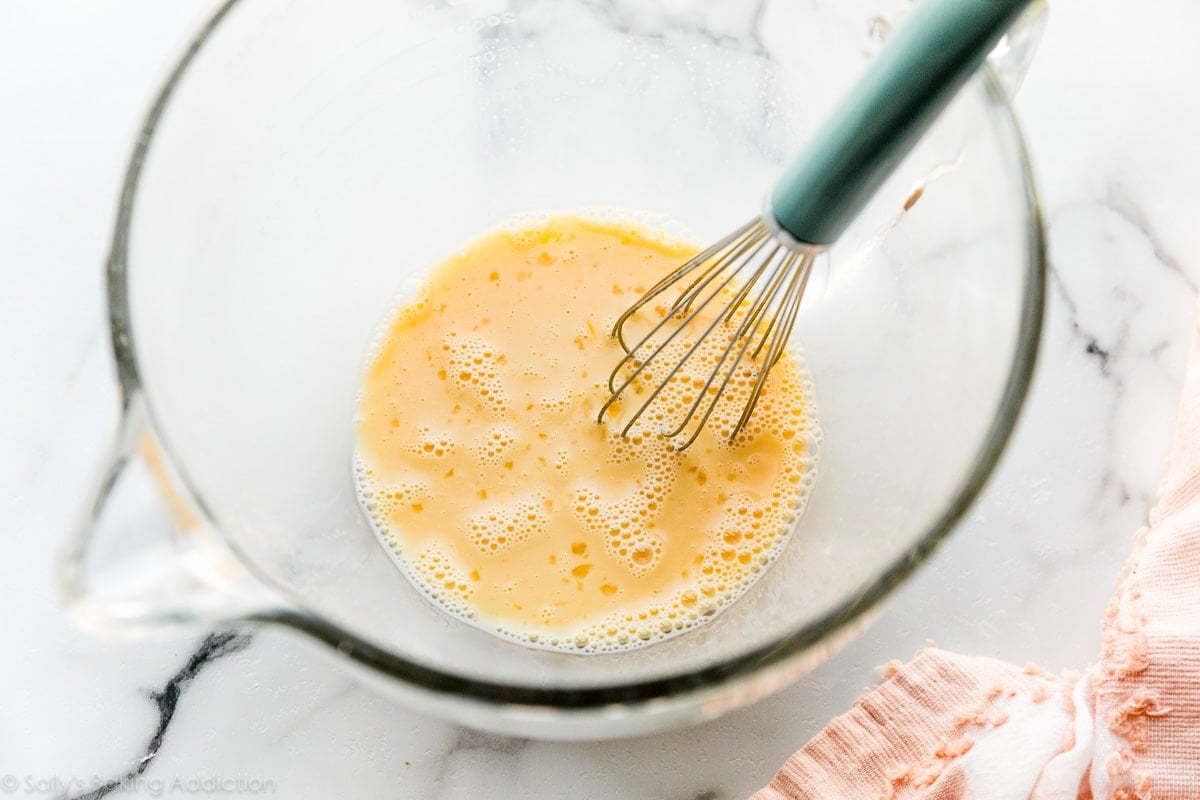
You need a food processor blender for this recipe. If you have neither, use a pastry cutter to cut the cold butter into the flour. An electric mixer will not work for this step. You are looking for pea-size crumbles of flour coated butter. This step is only possible if the butter is cold.
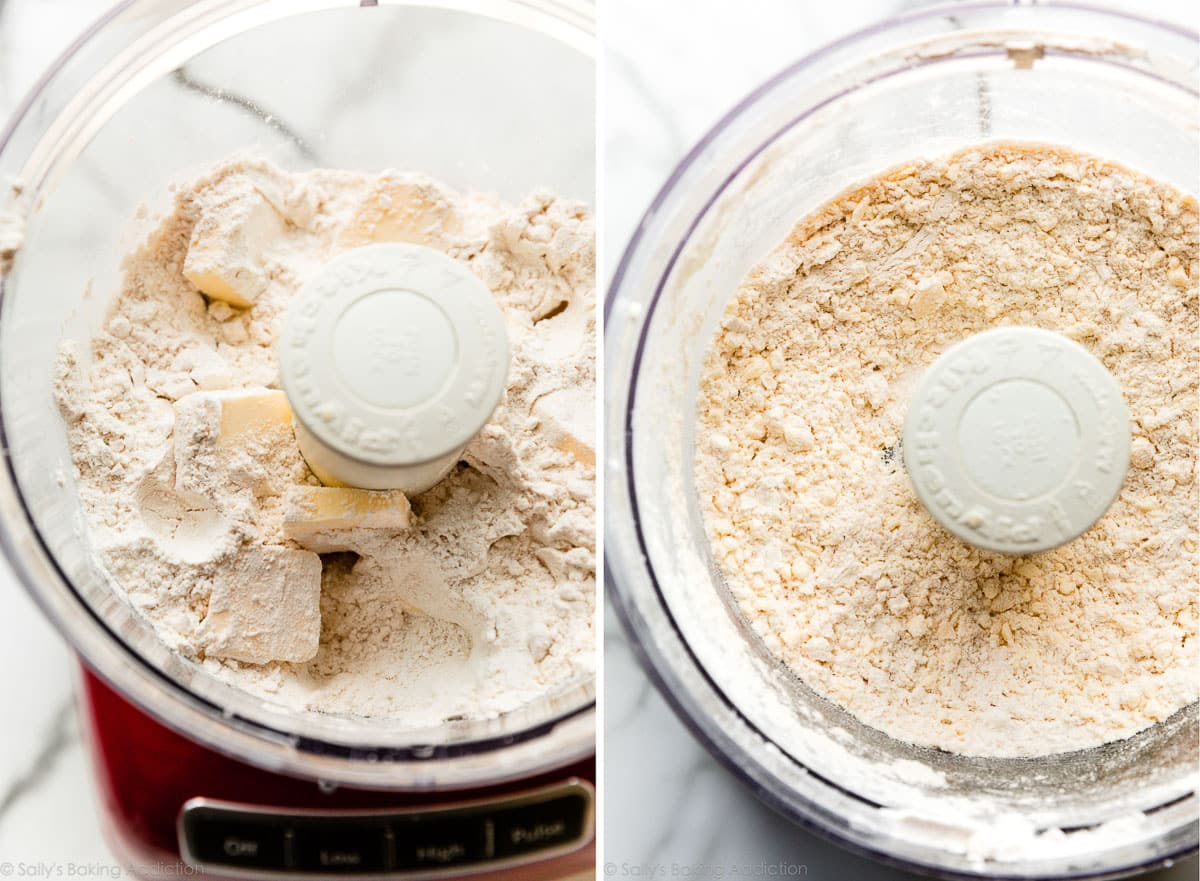
Pour the butter/flour crumbles into the wet ingredients and fold it together using a wooden spoon or rubber spatula. It is very sticky. Since this dough is so sticky, I do not recommend using an electric mixer. It will create a huge mess! There is minimal mixing required anyway—we don’t want to overwork this dough.

You’ll notice many bits of butter still visible in the dough—that’s a GOOD thing! Wrap the dough up tightly and refrigerate for at least 4 hours and up to 48 hours.
This is the 1st refrigeration.
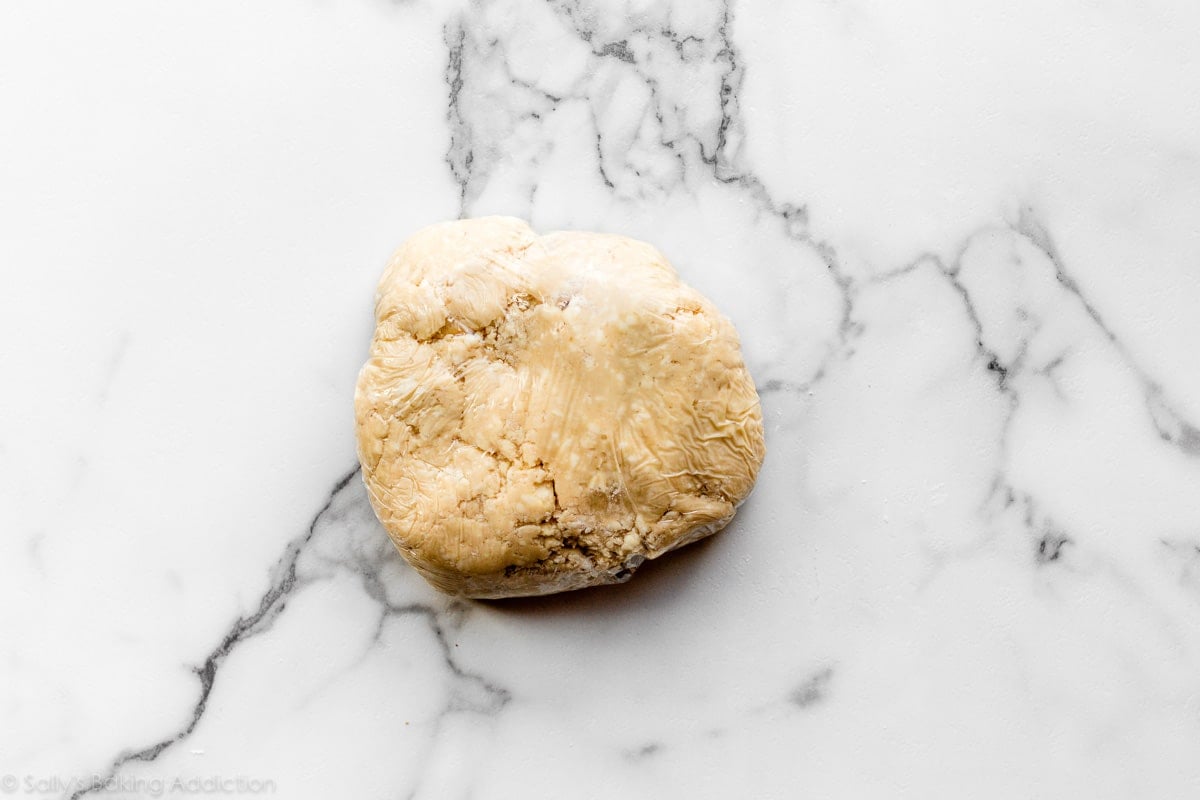
Shortcut Lamination
Now let’s do a variation of laminating aka rolling and folding dough and butter together. Remember when we made croissants and laminated the dough with a sheet of butter? The butter is IN this pastry dough. So, instead, we’re just rolling and folding the dough itself. Roll it out into a 15×8 inch rectangle:
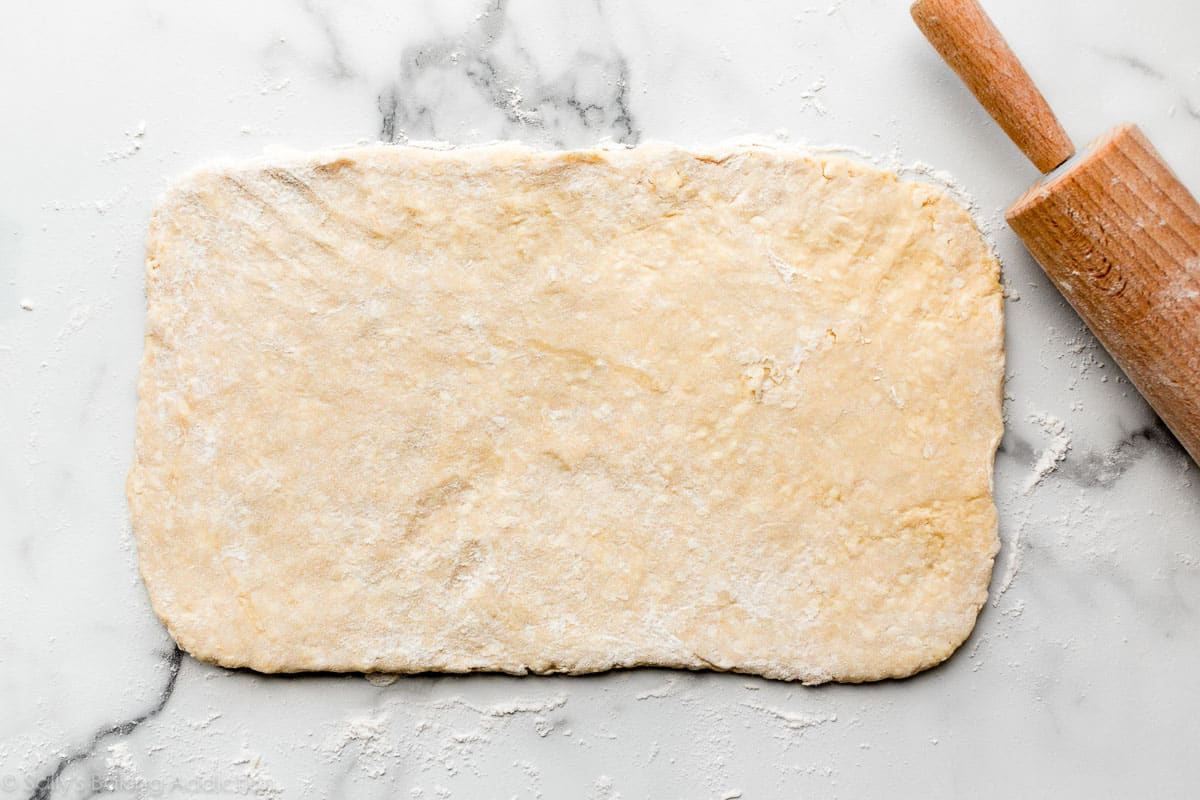
Fold it in thirds like a letter:
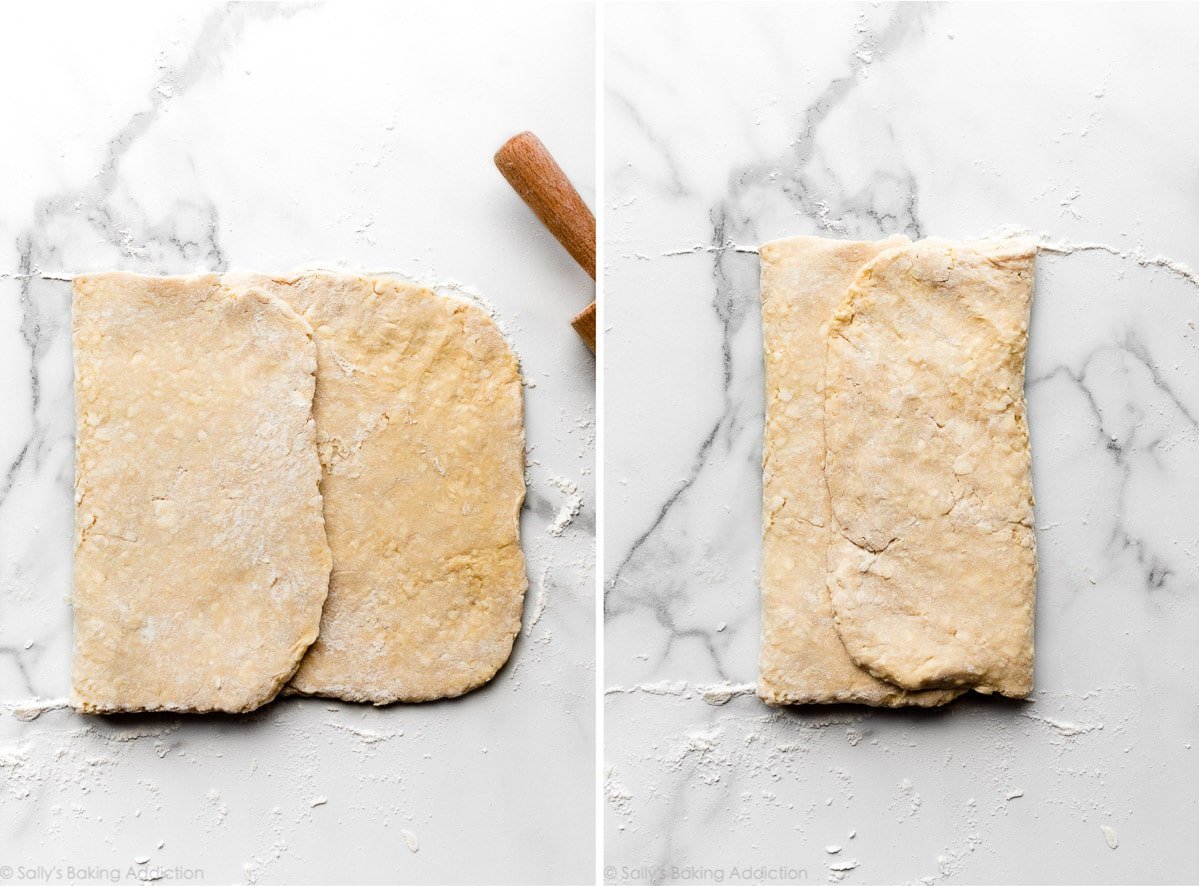
Turn it clockwise:

Then roll it out into a 15-inch rectangle again. Repeat the folding. Turn it clockwise again. Repeat rolling and folding 1 more time for a total of 3 times. Wrap the laminated dough up tightly and refrigerate for at least 1 hour and up to 24 hours.
This is the 2nd refrigeration.
How to Shape Homemade Breakfast Pastries
This dough recipe yields 16 breakfast pastries. See recipe note above about halving/freezing the dough. Cut the dough in half. (Work with only half the dough at once. Wrap half up and refrigerate until ready to use.) Cut the half of dough into 8 pieces. Roll into balls:
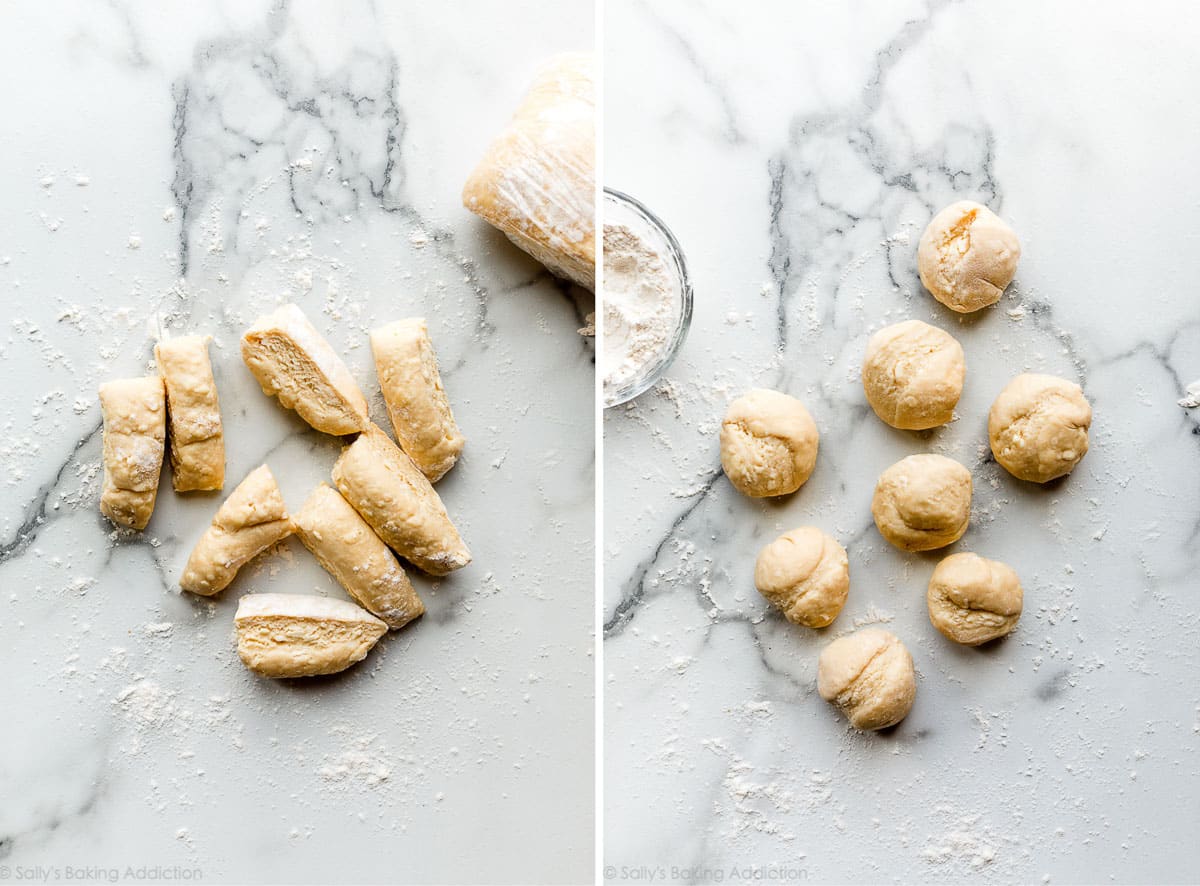
Flatten each into a 2.5 inch circle. Use your fingers to create a lip around the edges. Arrange pastries 3 inches apart on a lined baking sheet. Repeat with second half of dough.
Spoon your filling of choice inside each, then brush the edges of the pastries with egg wash, which is a combination of 1 egg and milk.
What is the purpose of an egg wash? It guarantees a shiny and crisp golden crust.
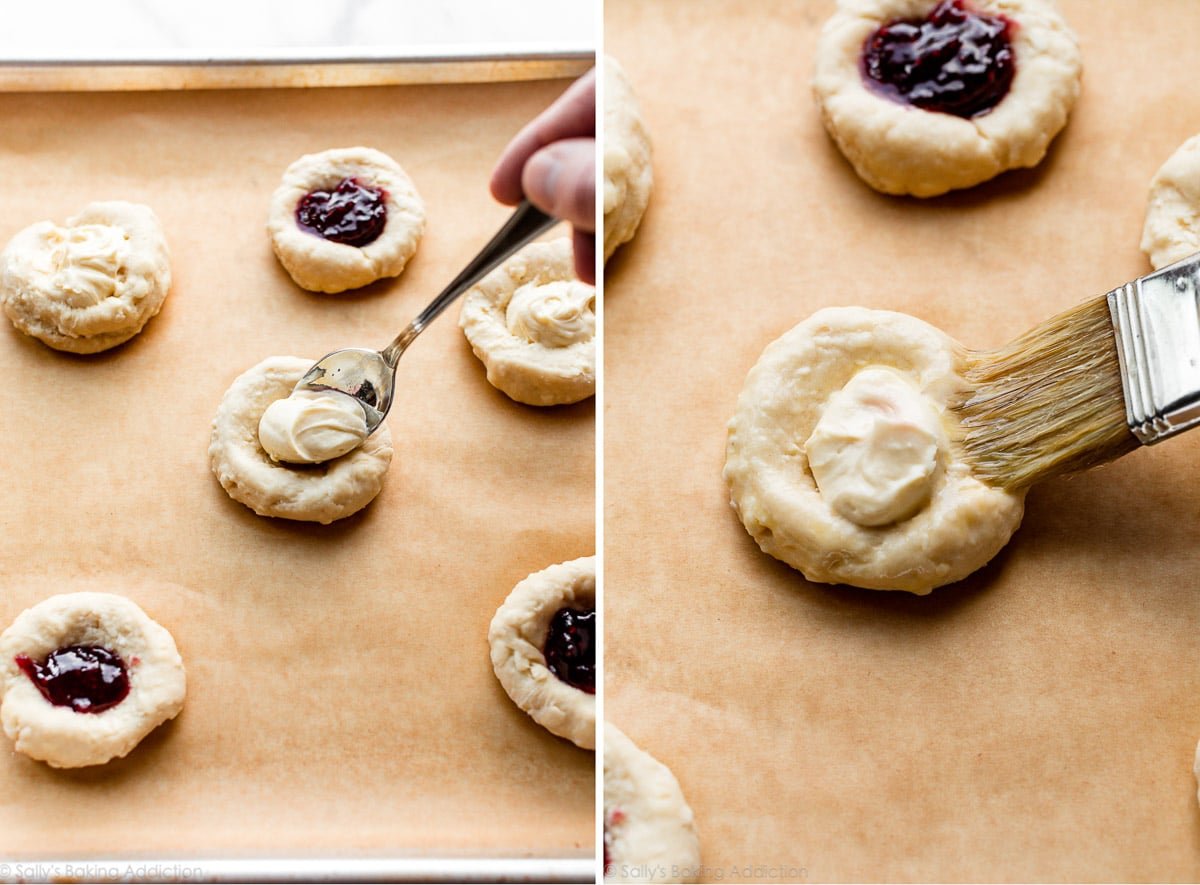
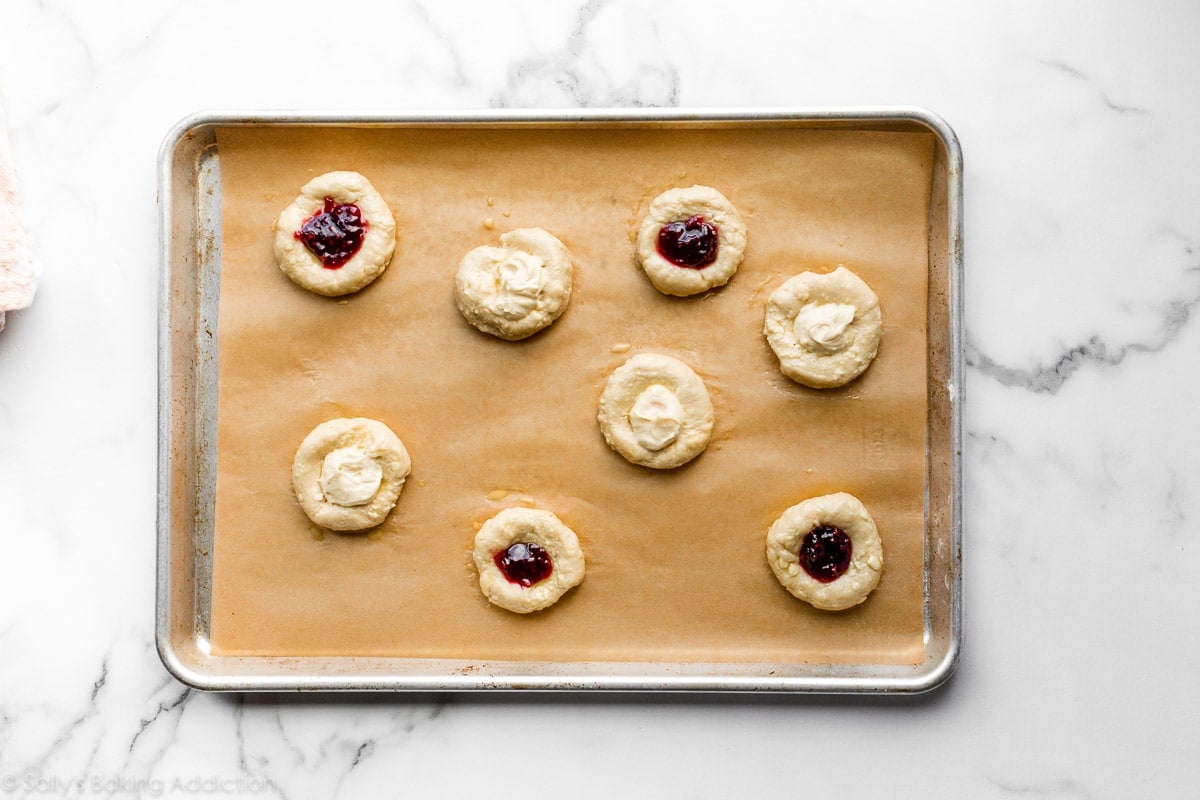
To help guarantee the shaped pastries hold their shape, chill them in the refrigerator as the oven preheats and even up to 1 hour. (See recipe note above.)
Bake until the breakfast pastries are golden brown. Cool for a few minutes, then drizzle with vanilla icing and serve!
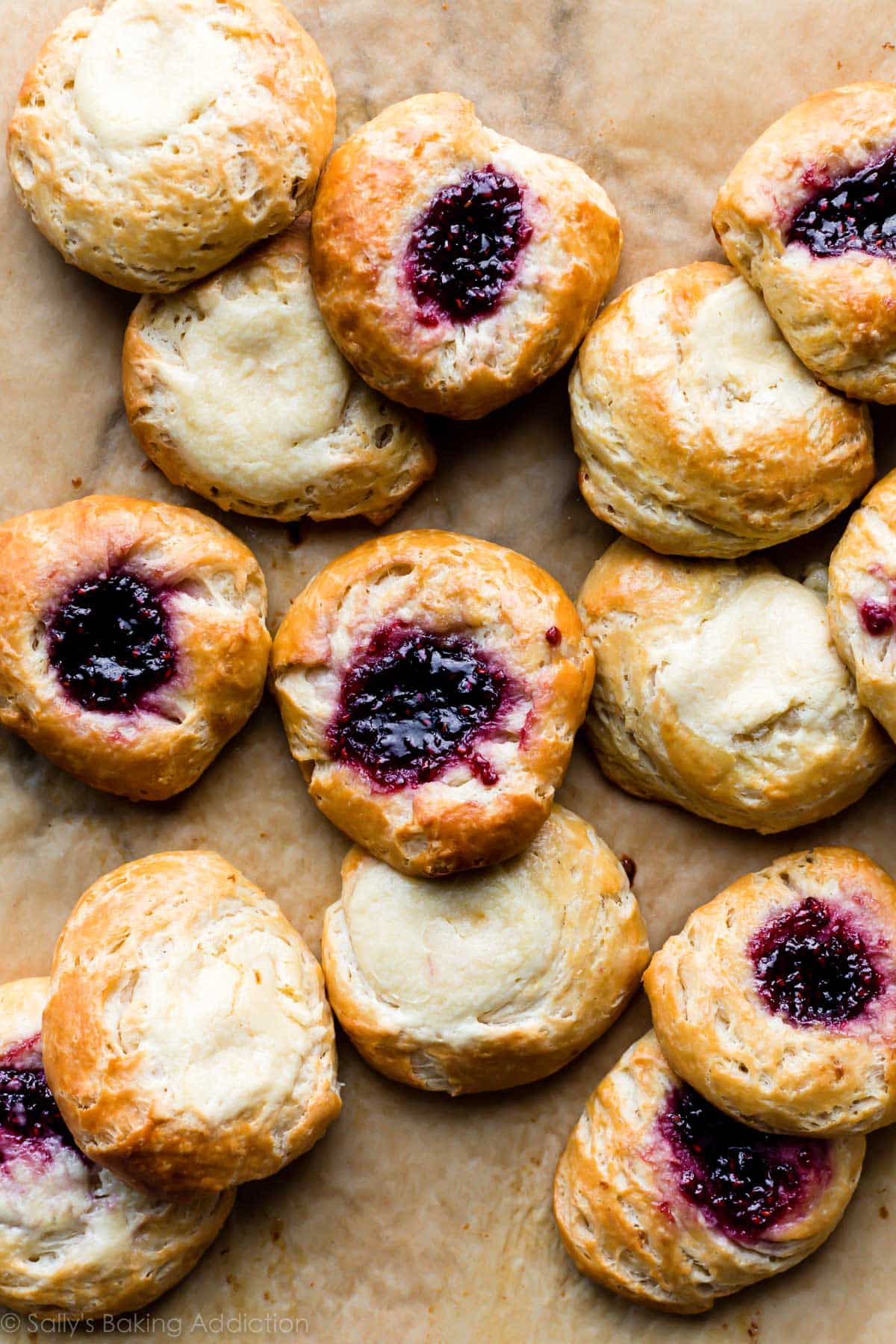
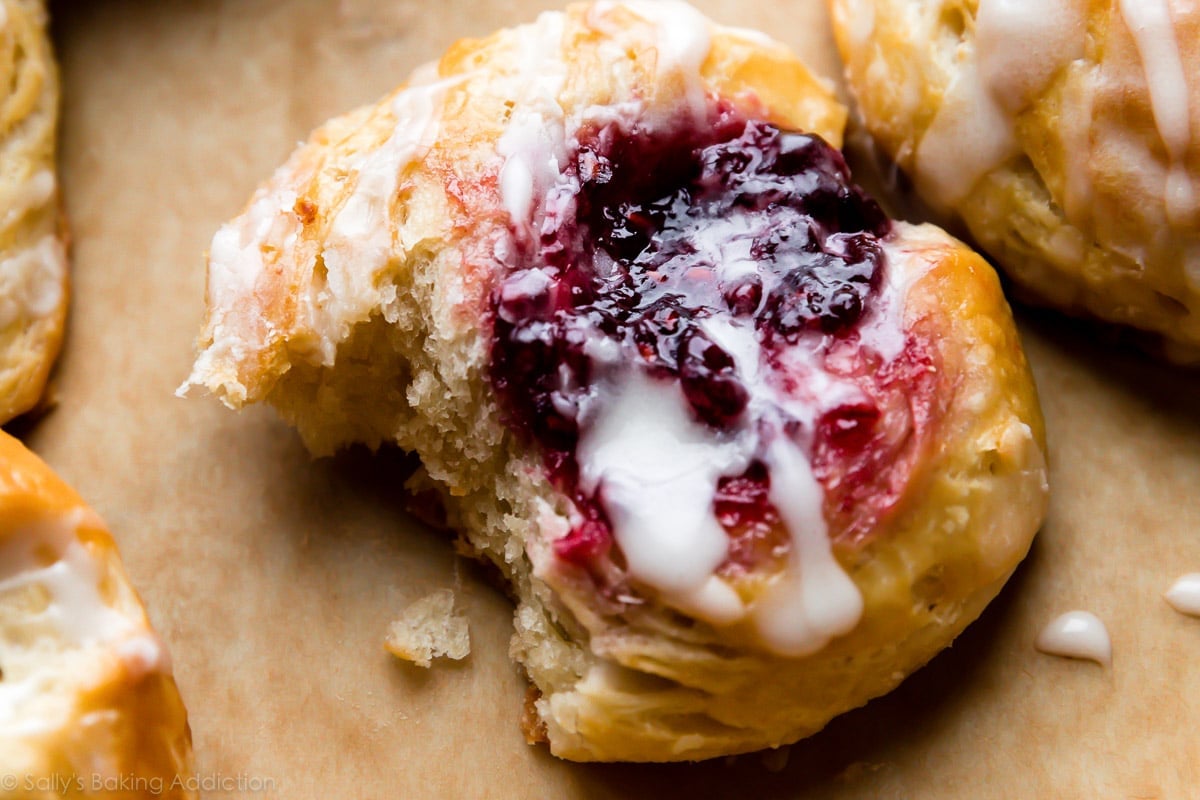




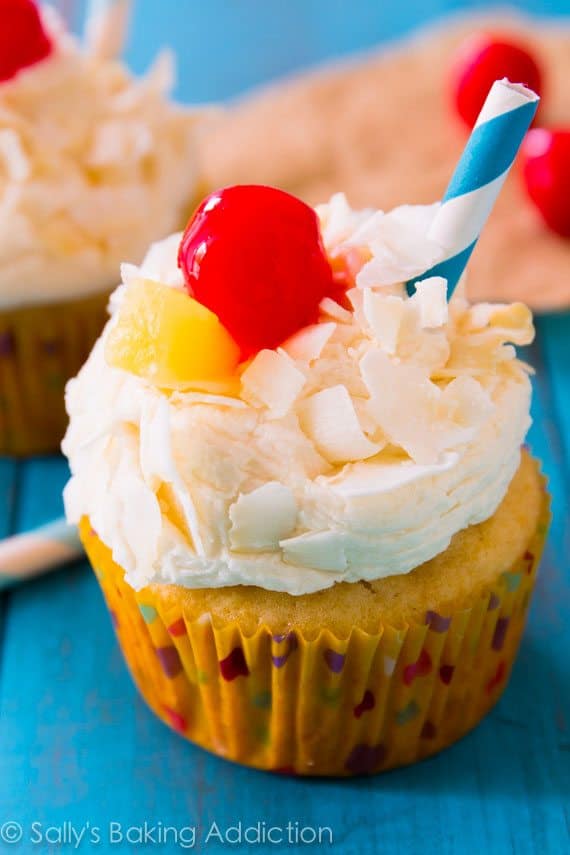












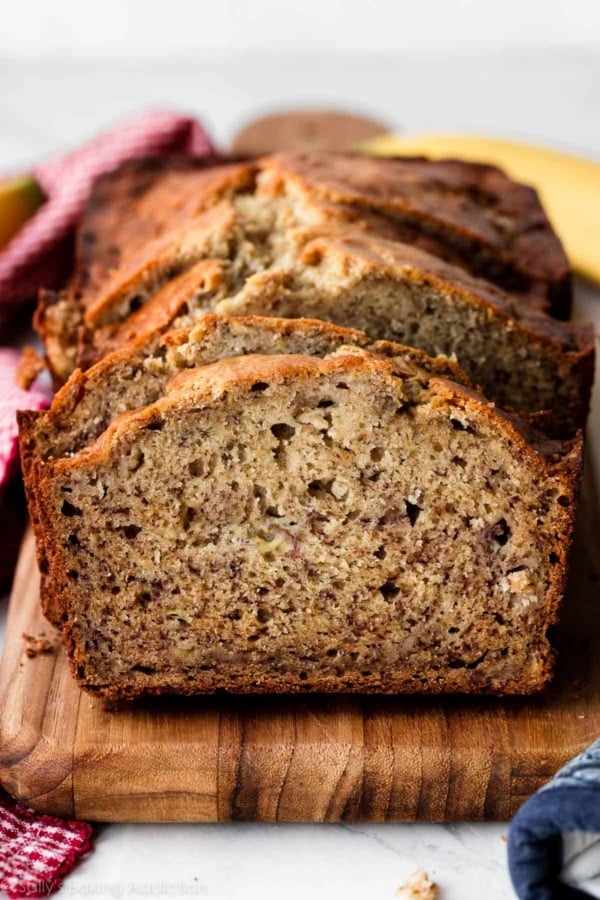

Reader Comments and Reviews
Delicious recipe!! Pretty easy to follow.
Love this recipe, can it be used to make turnovers?
Hi Debbie, here is our preferred dough for turnovers. Enjoy!
I had a cinnamon bun today from a European Bakery in town. The dough was different not tradition and not quite puff pastry so I’m wondering could it have been the Danish dough recipe you posted here? Would you be able to make cinnamon rolls with this dough?
Thanks love your recipes
Hi Ann, We haven’t tested this pastry dough that way before, but let us know if you do. There may be some butter leakage during bake time, but that’s normal with any way you shape the dough.
Though I have been baking for quite a number of years I have never got up the nerve to make Danish dough. I did try this however and was not disappointed! I am making it again for the second time in a week this time making ahead for Christmas morning. Thank you, for great recipes and always keeping my oven going!
These are SO delicious and worth the time and effort! I’m an extreme newbie baker and still very much figuring out how to bake with yeast… yet these came out PERFECTLY! They’re puffy, buttery, and wonderfully sweet. The best morning accompaniment to a cup of coffee.
My only note for anyone else using a dark pan, keep a close eye on them (for me, around the 18 minute mark) to make sure they didn’t get too browned on the bottom.
Can you freeze this recipe once it is fully baked with cream cheese filling? Or does this not work well?
Hi Alicia! We don’t recommend it. See recipe Notes for our recommended make-ahead instructions!
I love this recipe. I make them for friends and family and they always as for more. I let the dough sit overnight after I do the first Refrigeration
Hi.
Would this work with pumpkin for a filling?
Hi Samantha, Sure, you could give that a try!
This is an excellent recipe! Just tried it for the first time – I baked off 8 of them, half the recipe. I made the cream cheese filling and made three versions. 1 tbsp of cream cheese filling topped with 1) fresh blueberries; 2) homemade cranberry orange jam ; and 3) fresh peaches I sliced and precooked (just in case they wouldn’t cook sufficiently in the oven). Magnificent! We cannot decide which combo is best, except to say this recipe is a keeper!!! Highly recommend. Dont hesitate to try it. Very easy.
I have a question. Can I use pie and pastry flour in this recipe in stead of all purpose flour? Thanks!
Hi Michele, we fear pastry flour may actually be too light for these pastries. Doesn’t make sense since these are pastries, but we fear it wouldn’t hold up to all the butter inside the dough. If you try it, however, please let us know.
I can’t wait to try this one. One question, are there other shapes (other than rounds) that can achieve the same result. I’m not sure what is called but the long rectangler braided look? Or is the round shape the best?
Hi Sandy, here is our pastry braid recipe and tutorial—hope this helps!
I’m going to try making these in advance for brunch next Tuesday. Steps 1-4 on Saturday evening. On Monday afternoon I’ll do the folds then back in the fridge till Tuesday morning when I’ll shape, refrigerate, then bake.
So excited to see how they turn out. I’ll report back here!
I’ve eaten way too many! This is the first time I’ve made something fancy and complicated and it still didn’t fail. I love the cream cheese style filling the most. Next time I’m going to make a lot more lol. I ate one too many. The only thing strange about mine are that they didn’t ooze out butter? Not sure why but it didn’t matter. It was still flaky and absolutely amazing.
Can the danish be frozen after baking?
Hi Marcia, definitely! See the recipe notes for Make Ahead & Freezing Instructions.
can I make bear claws and other pastries with this dough?
Hi Katie, we can’t see why not! Let us know if you give anything a try.
I can’t wait to see how these turn out. I am at the 2nd refrigeration stage. I pulled the dough out for that stage after 4 hours… there were still quite a lot of butter pieces visible. Is this normal? Thanks!!
Hi Samantha! Yes, that’s normal!
They are so good! Unfortunately even at the minimum time suggested the bottoms were really over done on the first batch. The second batch I put in for the minimum time at 375 and they too came out overdone on the bottoms. Suggestions? Our oven is relatively new so I don’t think the temp is off.
Hi Samantha! Most ovens, even new ovens, are not the temperature they say they are. We always recommend using an in-oven thermometer so you know the exact temperature of your oven. And, as always, keep an eye on your baked goods while they bake so you can pull them out if they are baking faster.
Try using a light colored pan, the darker pans always burn the bottoms of baked goods
I used this recipe to make breakfast pastries for the first time and I am not sorry that I did because they were wonderful! They looked great and everyone I shared them with loved them. I really appreciate the step by step detailed directions to help me achieve success. Wonderful recipe!
This is an amazing recipe! Your step-by-step instructions made it so easy! I used the cream cheese filling and it was SO delicious, my family and friends loved them! Thank you!!
Quick question, can I double this recipe or is it recommended to make 2 separate batches?
Hi Brianne, we’re so glad you enjoyed the pastries! For best results, we recommend making 2 separate batches rather than doubling.
Your step-by-step instructions and video tutorial made this daunting recipe very achievable!! I need to work on shaping the individual pastries and getting the right size print for the filling, but that’s on me. Delicious, flaky, and oh so fancy!